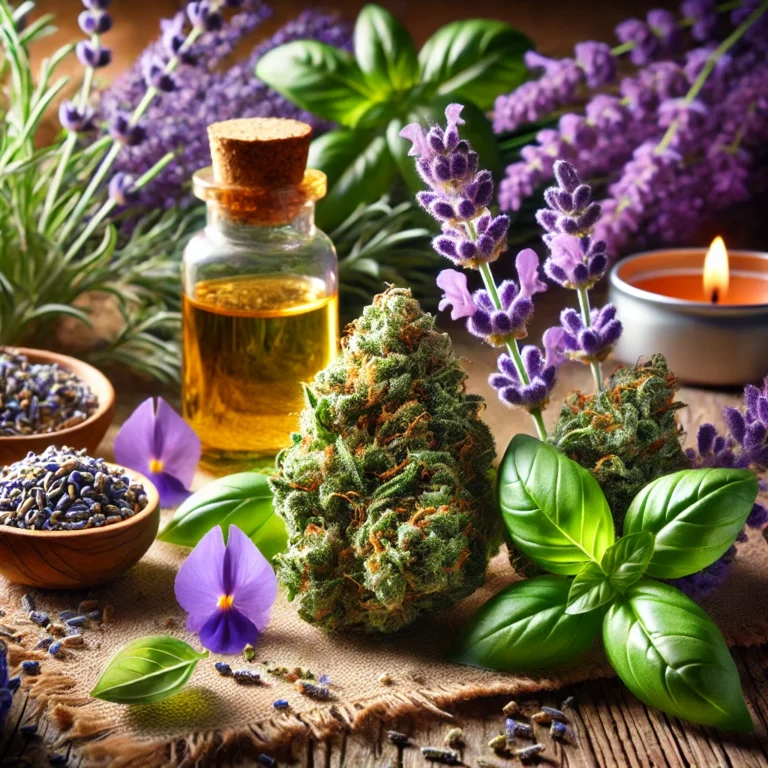
My fascination with linalool terpene began when I stumbled upon its myriad of benefits and its intriguing presence in nature. Known for its soothing effects, linalool has become one of my go-to choices for stress relief and relaxation. Throughout my journey, I’ve discovered how this terpene can enhance my cannabis experience, promoting a peaceful mind and body. Join me as I explore the unique benefits and effects of linalool in cannabis!
Linalool is one of my favorite terpenes, known for its soothing floral aroma, similar to what you’d find in lavender and mint. You’ve probably encountered it in nature without even realizing—think fresh lavender fields or the calming scent of basil. In cannabis, linalool-rich strains like Amnesia Haze, Do-Si-Dos, and LA Confidential stand out for their relaxing effects. These strains are popular for their ability to ease stress, promote better sleep, and even help with anxiety. Whether you’re looking for a strain to unwind after a long day or something to help calm your mind, linalool-packed cannabis offers both aromatherapy benefits and a gentle, mellow high.

I love exploring fascinating natural compounds, and Linalool is one of my favorites! This aromatic terpene is a superstar in the plant world – you’ll find it creating that wonderful floral scent in lavender, adding a sweet touch to citrus fruits, and even spicing up herbs like basil and coriander. When I smell that distinctive fresh, floral aroma in my garden, there’s a good chance Linalool is responsible. What’s really interesting is that this terpene isn’t just about pleasant scents – it’s also one of the key compounds found in cannabis, contributing to that distinct aroma in certain strains and potentially playing a role in the plant’s effects. Many cannabis enthusiasts specifically seek out Linalool-rich strains for their unique profiles. As someone who’s fascinated by plant chemistry, I find it amazing how this single molecule appears throughout nature, from our favorite cooking herbs to fragrant flowers.
This aromatic terpene is a superstar in the plant world – you’ll find it creating that wonderful floral scent in lavender, adding a sweet touch to citrus fruits, and even spicing up herbs like basil and coriander. What’s really interesting is that this terpene isn’t just about pleasant scents – it’s also one of the key compounds found in cannabis, contributing to that distinct aroma in certain strains and potentially playing a role in the plant’s effects. Many cannabis enthusiasts specifically seek out Linalool-rich strains for their unique profiles and stress relief.
When I first started learning about terpenes, linalool immediately stood out because of its distinct floral aroma. It’s the same soothing scent you get from lavender, rosewood, and coriander, which makes it a common ingredient in essential oils and perfumes. You’ll also find it in foods like basil and cinnamon, adding a delicate, slightly spicy fragrance. When it comes to cannabis, linalool gives certain strains a calming, floral note that enhances the overall aroma profile. I love how strains rich in linalool, like Granddaddy Purple or Kosher Kush, not only smell amazing but also bring that familiar relaxing vibe you get from lavender-scented candles or herbal teas. It’s fascinating how nature blends these aromatic experiences across food, plants, and cannabis!

Linalool is renowned for its diverse therapeutic properties, making it a valuable component in the world of terpenes. This terpene exhibits anti-inflammatory, analgesic, and antimicrobial effects, which contribute to its ability to promote healing and alleviate various ailments. Additionally, linalool is known for its calming and sedative properties, making it a popular choice for individuals seeking relaxation and stress relief.
Beyond its therapeutic properties, linalool offers notable health benefits that can support overall wellness. Studies have shown that linalool possesses antioxidant properties, helping to combat oxidative stress and reduce the risk of chronic diseases. Furthermore, linalool may have anti-anxiety and anticonvulsant effects, making it a potentially beneficial terpene for individuals dealing with anxiety disorders or seizures.
Health Benefit | Description |
Antioxidant Properties | Helps combat oxidative stress |
Anti-Anxiety Effects | Assists in reducing anxiety levels |
Anticonvulsant Effects | May help manage seizures |
Researchers found that linalool exhibits anti-inflammatory and antioxidant properties, which may contribute to neuroprotective effects in the brain.PMC
This suggests that linalool-rich essential oils could play a role in supporting brain health. It’s exciting to see scientific evidence backing the therapeutic uses of natural compounds like linalool!


Through my research, I’ve discovered that Linalool works by interacting with our body’s serotonin receptors and potentially lowering cortisol levels (our stress hormone). What really excites me is how this natural compound can help promote better sleep quality and reduce feelings of anxiety without harsh side effects. You’ll find it working its magic in aromatherapy practices, where lavender – a Linalool-rich plant – is often used to create a sense of peace and relaxation. In cannabis strains containing high levels of Linalool, users often report feeling a gentle wave of emotional balance and mental clarity. I think it’s amazing how this single compound found in so many plants can have such a profound impact on our emotional state, potentially helping with everything from mild stress to more serious mood concerns.
Incorporating linalool into your daily routine can bring about a range of benefits that enhance your overall well-being. From consumption methods to safety considerations, here are some ways to effectively include linalool in your regimen:
I’m excited to share all the fascinating ways we can experience Linalool’s benefits! When it comes to cannabis consumption, the method you choose can significantly impact how you experience this terpene. Vaporizing cannabis at lower temperatures (around 388°F/198°C) helps preserve Linalool’s integrity, allowing me to fully appreciate its effects. Smoking, while effective, can destroy some of the delicate terpenes due to the high temperatures. For a non-cannabis approach, I love using Linalool-rich essential oils in diffusers or adding a few drops of lavender oil to my bath water for direct absorption through the skin. You can also find this terpene naturally in many common herbs – I often make calming teas with dried lavender or lemon balm. Topical applications, like lotions or massage oils containing Linalool, work well for localized effects through skin absorption. What’s really interesting is how dabbing cannabis concentrates at controlled temperatures can deliver a pure, potent dose of Linalool, though I always remind people that the effects will be more intense than traditional methods. You can even get your daily dose by cooking with fresh herbs like basil and coriander, which naturally contain this beneficial terpene.
I’m always amazed by the fascinating synergistic effects that happen when Linalool teams up with other terpenes in cannabis – it’s like watching a beautiful chemical dance! When Linalool partners with Myrcene, I’ve found it creates an incredibly relaxing combination that’s perfect for evening use, potentially enhancing sleep quality while deeply soothing both mind and body. One of my favorite synergies is when Linalool works alongside Limonene – this dynamic duo may help reduce anxiety while maintaining mental clarity, unlike the foggy feeling you might get from Linalool alone. I get particularly excited about strains that combine Linalool with Beta-Caryophyllene, as this pairing could offer enhanced mood-lifting properties while potentially providing stronger anti-inflammatory effects. When you find cannabis varieties that contain Linalool along with Pinene, you might experience improved mental focus alongside the calming effects, which I think is perfect for those dealing with anxiety but needing to stay alert. The best part about these combinations is how they demonstrate the entourage effect – where multiple cannabis compounds work together to create effects more powerful than any single compound could achieve on its own.
While incorporating linalool into your routine, it’s essential to consider dosage and safety guidelines to ensure a positive experience. The appropriate dosage of linalool can vary depending on factors such as individual tolerance, the form of consumption, and desired effects. It’s recommended to start with a low dose and gradually increase as needed to gauge your body’s response.
Safety considerations include choosing high-quality sources of linalool, such as organic products, or products that have been tested for mold. Proper dilution and application methods are crucial to prevent adverse reactions. If you have any existing medical conditions or are pregnant or nursing, it’s advisable to consult with a healthcare professional before using linalool to ensure that it is safe for you.
By understanding the various consumption methods, exploring terpene combinations, and adhering to dosage and safety considerations, you can effectively incorporate linalool into your daily routine to harness its potential benefits for your well-being.
Join our community of cannabis enthusiasts and terpene explorers! Get exclusive insights, in-depth guides, and the latest discoveries. No spam—just pure, aromatic knowledge delivered straight to your inbox.
Subscribe now and elevate your cannabis wisdom!